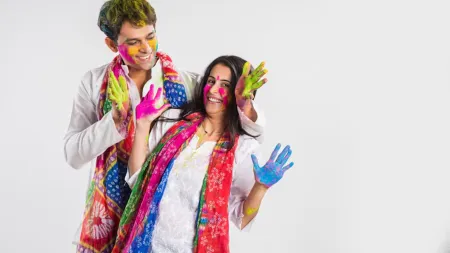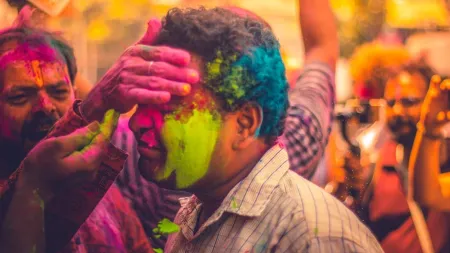‘Would you like to live every day the same way?’: Chef Sanjeev Kapoor discusses importance of experimentation in cooking
Only 90’s kids would understand the true importance of ‘Khana Khazana’, hosted by Chef Sanjeev Kapoor, which brought him into prominence. My mother would probably be cradling me in her arms while tuning into his show, which made him a household name in the culinary industry. It would be right to say that Sanjeev Kapoor was one of India’s first chefs who made cooking as easy as slicing a piece of butter for millions of Indians who watched him over television (enough food puns for now).
Now, fast forward 30 years, and you’ll find him breathing a new life into home cooking with his prominent social media presence — from Instagram to YouTube — where he has found a space to share his artistry with the Zoomers who might not have lived enough years to understand his brilliance.

However, he feels this has been a seamless progression, which felt almost effortless to him. “Be it food. Be it life. You naturally adapt if you keep your eyes and ears open…it’s not a transition; these changes happen naturally,” chef Sanjeev Kapoor told indianexpress.com.
Being a part of the culinary community for decades, he has constantly endeavoured to give back to society in whichever possible way. Continuing his relationship with Akshaya Patra — a non-profit trust — the chef joined hands with their latest fundraiser, in collaboration with Share Our Strength and The Breakfast Revolution, to raise money for the “daily breakfasts and lunches of over 10,000 underprivileged school children”.
Spearheading the fundraiser with other renowned chefs such as Manish Mehrotra, Asma Khan, Prateek Sadhu and Anil Rohira, chef Sanjeev Kapoor aimed to raise enough money to provide wholesome meals to the children for the upcoming academic year.
When indianexpress.com got the chance to interview the culinary expert, we delved right into his remarkable journey spanning across two separate centuries. Excerpts:
Q. From ‘Khana Khazana’ to Yellow Chilli and now your substantial presence on social media — how do you think this transition happened in your career?
Chef Sanjeev Kapoor: I don’t think there needs to be any transition. You simply work with relevance. Whether it’s food or life, it’s not about transitioning; it’s about keeping your eyes and ears open. Social media didn’t exist in my day and age, but I adapted to it when it came. These things happen effortlessly.
View this post on Instagram
A post shared by Sanjeev Kapoor (@sanjeevkapoor)
Q. How do you manage to stay relevant all these years — whether it’s through TV or reels?
Chef Sanjeev Kapoor: Any form of medium is as important as the creators themselves, because they wouldn’t exist without us. It’s always a symbiotic relationship. You’re reaching out with content and that’s what people are consuming.
Q. You’re in a unique position to observe and perhaps even set culinary trends — which are a few ones you are particularly fond of?
Chef Sanjeev Kapoor: People might have started talking about millets now, but individuals like us noticed it many years ago. In 2017, I collaborated with the Ministry of Food Processing Industries in Delhi to emphasise dishes made with millets. We were ahead of the curve, internationally and at home.
Now, our excitement lies in making sustainability real. It’s not just a hot topic; it’s about implementing real change. Sustainability and biodiversity might sound like heavy words, and they may not resonate with everyone immediately. But how do we make them relevant to everybody?
For instance, for the past 10 years, in Mumbai, where we reside, we’ve been segregating our garbage. Even though it all gets mixed up together. Does this mean our efforts are futile? We are consistently working on what we believe is the right path.
These are behavioural changes that take time. It’s essential that these changes also extend beyond our homes because the largest consumption comes from outside home cooking.
View this post on Instagram
A post shared by Sanjeev Kapoor (@sanjeevkapoor)
Q. As a frequent traveller, is there any particular destination that stands out for you?
Chef Sanjeev Kapoor: When I travel within India, I always aim to explore new places. And each time I visit a destination, I’m eager to try out something different. For example, whether I’m revisiting a country like Japan, which I love, or exploring places like Spain, Kerala, or Maharashtra, I make a conscious effort to seek out new experiences. I don’t like to get stuck with the same old routine; I prefer exploring fresh experiences.
Q. Hypothetically speaking, is there any cuisine you could eat for the rest of your life?
Chef Sanjeev Kapoor: Why would I do that? Would you like to live every day the same way? That’s so boring. Would you want to write the same article you write every day, for the rest of your life? You would not, right? (jokingly)
View this post on Instagram
A post shared by The Akshaya Patra Foundation (@theakshayapatrafoundation)
Q. Do you have any advice for chefs who are just starting out their careers?
Chef Sanjeev Kapoor: Learn and hone both knowledge and skills. Work diligently and intelligently on both fronts. So, when starting out, focus on developing your skills and acquiring knowledge. But the most crucial aspect is your value system — the often-overlooked lessons taught by parents and teachers about hard work and discipline. These form the foundation of your character and are critical for success. So, three things: prioritise skill development, acquire knowledge and integrate both with the strong value system. Skills are sharpened when coupled with knowledge and a great value system guides your journey.
Q. Can you share an easy, traditional homemade recipe with us?
Chef Sanjeev Kapoor: I’ll share with you a recipe of Litti Chokha, which we also presented at the fundraiser.
Ingredients
Dough
*1 cup pearl millet (bajra) flour
*Salt
*1 tbsp ghee + to grease + as required
*A pinch of baking soda
Sattu Mousse
*½ cup sattu
*2 tbsps red chilli pickle masala
*1 tbsp mustard oil
Baingan Chokha
*1 large green brinjal
*6-8 garlic cloves
*Oil for greasing
*2-3 light green chillies, stemmed
*Salt to taste
*Black salt to taste
*4 tbsps mustard oil
*2 tbsps chopped fresh coriander leaves
*½ medium onion, chopped
Tomato Chutney
*2 medium tomatoes
*1 medium red capsicum
*3-4 garlic cloves
*2 dried red chillies, stemmed, soaked and drained
*1 tsp agar agar powder
*Black salt to taste
*Salt to taste
*2 tsps sugar
*Mustard microgreens for garnish
 Litti Chokha recipe. (Credit: Chef Sanjeev Kapoor)
Litti Chokha recipe. (Credit: Chef Sanjeev Kapoor)
Method
1. For the dough, heat 1 cup water in a deep non-stick pan. Once the water comes to a boil, add salt, ghee and mix well.
Add pearl millet flour, baking soda and mix well. Take the pan off the heat, cover with a lid and set aside.
2. Transfer the dough to a steel plate and knead well until smooth.
3. Preheat the oven at 180⁰C.
4. Divide the dough into 30-gram portions. Roll into balls and flatten slightly.
Arrange on a greased baking tray and bake for 15-20 minutes.
5. Roast the baked littis on an open flame and allow to cool slightly. Dip the littis in ghee and drain out.
6. Scoop the centre to make a cavity.
7. To make sattu mousse, take a grinder jar, add sattu, red chilli pickle masala, mustard oil and grind to fine paste.
8. Transfer in a piping bag and set aside.
9. To make baingan chokha, make slits on the brinjal, insert garlic cloves, apply some oil and roast on direct heat till charred.
10. Allow to cool.
11. Similarly, roast the green chillies on direct heat till charred. Set aside to cool down.
12. Peel the skin of brinjal, remove the seeds and chop finely. Similarly peel the green chillies and chop finely.
13. Transfer the brinjal and green chillies in a bowl, add salt, black salt, mustard oil, coriander and onion and mix well.
14. To make tomato chutney, roast the tomatoes, red capsicum and garlic cloves on open heat till charred. Set aside to cool down.
15. Peel the tomatoes, red capsicum and transfer in a grinder jar. Add garlic cloves, dried red chillies and grind to fine paste.
16. Heat a nonstick pan. Transfer the ground paste, agar agar powder, black salt, salt and sugar and cook for 5 to 7 minutes. Allow to cool and fill in the piping bag.
17. Arrange the littis on a serving plate, pipe the sattu mousse in the cavity, pipe the tomato chutney on top.
18. Garnish with mustard microgreens and serve.
Disclaimer: The copyright of this article belongs to the original author. Reposting this article is solely for the purpose of information dissemination and does not constitute any investment advice. If there is any infringement, please contact us immediately. We will make corrections or deletions as necessary. Thank you.





